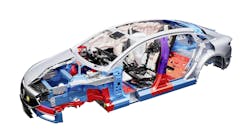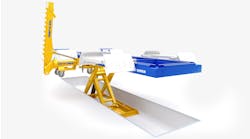It's happened more than once that I have come across a shop who had already cut into a vehicle and was deep into the repair before they asked for advice on how to weld or repair something. My response is, “Where are your procedures for this vehicle?” I'm then often met with a blank stare, followed by a question of what a procedure even is. After explaining what a procedure is, the technicians’ and managers’ response was, “There’s a guide telling me how to do my job?” Just like on the mechanical side (example: instructions on how to take apart an engine and put it back together with specifications on how to torque down bolts, fluids, etc.), yes, there are guidelines to repairs.
Gathering information
The conversation on the procedures and position statements needs to be UP FRONT. Procedures may vary from manufacturers, but in general, they may outline what and how a part can be replaced. These sometimes long and extensive text guides can be shown with various detail of pictures. These procedures are very specific to the vehicle. They can even be updated daily, so I recommend accessing them at the time of the repair, not printing them and saving them for later use (example: you work on the same model a lot).
A position statement will typically be a broad document from an OEM that applies to all models. For example, a manufacturer may have a position statement starting February of this year that you can no longer use heat on structural frame components or that you can’t repair wheels beyond minor refinishing. These are typically smaller one-page statements, in contrast to the in-depth multi-page guides of a procedure. They can be used for documentation and repair decisions for reasons on why or why not to repair something.
Assessing the repair job
It's crucial to look this info up before fixing, ordering, and knowing if you have the tools, skills, ordering parts and materials, and more. Worse is how often I see shops still trying to fix a car they have no business fixing. For example, they attempted to fix an aluminum vehicle with no aluminum welder or no rivet gun. Guess how that repair went? And even if they had those broad equipment categories, were they even on an approved equipment list by the OEM to follow the modern collision repair guidelines of their vehicle?
It boils down to evaluating your shops’ capability: the available technician skill sets along with considering the overall repair options before even starting the repair.
Additional potential repair points to consider include:
- Can you repair the structural damage with heat?
We’re not talking about a roaring torch here anymore. Heat can be a couple millisecond zap from a reusable dent puller, welding on a small pull tab, or a squeeze-type resistance spot welder. The best tool can become a liability and has its time and place to be used.
- Can you repair the non-structural dents with heat?
This may mean no traditional body tools like weld-on "studs" or other unique high-tech equipment that heats up even a little bit or that might change the scope of the repair.
This allows other interesting repair processes such as glue-pulling or other “cold” methods to be employed. This can greatly change the repair plan. In the repair procedures, you may have several areas on the same vehicle with different repair techniques required, and others where those same techniques are not allowed. But you'll sometimes have a tech just go at it with the same familiar tools for the sake of getting the job done. Having a thorough estimate repair plan along with visual cues written on the car can help tremendously in the shop when you have many repair options going on.
- Advanced and other material considerations and discussions: Silicon bronze, riveting (including all the unique rivets) glue choices/storage, etc.
Where to find procedures and position statements
So, you may be asking how do you even access these repair procedures or position statements? Here are many options to suit your needs for how to track down these procedures:
OEM is the gold standard source that should be sought. That may be a problem in itself, because it's not always an obvious manufacturer, such as Ford's, collision website address that is pulled up, even from, say, a Google search. That's how the shop I referenced was even calling me. It's actually accessed through its "Motorcraft" brand. So that in itself is a discussion that can be expanded, not to mention subscription costs, time frames on access, how often you should access for estimates as a business, saving the material for future use or not, and more. Even the ones who have paid access sometimes don't realize the website address name as they're just clicking it on the shop's computer that the local IT person saved as a shortcut for example.
Third-party - Alldata, Sun Collision, various estimating systems, etc.
These are very common data services that a shop may already be using and can add on. So, this has a great advantage of familiarity for the person accessing or even consistent use across all OEMs for the info. This may also have its faults that need to be explained, because, for example, this is essentially info licensed by these companies from the OEMs. Problems that can arise from poor quality sources are that the info can become outdated, or photos, specifications, links, and more may not transfer over when they essentially "copy" these manuals. So, having a quality service is crucial.
Information awareness sites are sites that are kind of related to the third party, such as OEM1Stop, which links information back to OEMs and shows things like position statements, links sometimes to their collision websites, and other broad info. Yes, this info is ultimately in the above sources (which you may not have access to), but it's presented simply and quickly and for a lot of brands. This may help someone make a quick total decision or look up a fast position statement document for an insurance adjuster, instead of digging through extensive procedure pages, for example. Other sites include DEG Gateway for additional estimating information.
Parts-ordering - Most of the time, you're ordering that structural part from a branded dealership...so why not simply ask them to provide the documentation for that rear body panel or quarter panel you're ordering and slap it on the part in the box they're sending it out in? Heck, they'll probably email it over to you. Now, the only reason why you wouldn't be allowed to "get" that procedure would also mean you shouldn't be able to get that part either. So, if you get that response, I wouldn't be ordering that part in the first place. Some OEMs require you to be certified to buy certain parts, but if you're able to buy the part, simply ask for the procedure with the part. The only thing I caution with this scenario is you’re already ordering parts along with getting the procedure for something you haven’t reviewed the fine details yet. So, before ordering, the prudent first step is to see if your shop is capable of completing the repair.
Whichever option works best to implement in your shop during your estimating check-in phase is ultimately the one that allows you to acknowledge the repair procedure and your shop’s capability. This information is critical in assessing your ability to do a proper repair and avoid liability. This also could open up to allow you to write a better estimate by now having the full repair plan of information needed to fix the vehicle.
Do you want to be a "rock star?"
I'm frustrated by how some in the industry are not properly aware of needed procedures. When I advise people to get the procedure on a big repair, I often get a deer-in-the-headlights look indicating they don’t even know they exist.
Others do get it and are rock stars in this conversation. So, it appears there's still a big divide in this industry. This topic isn’t going away as the complexity and repair requirements tighten up from manufacturers.





